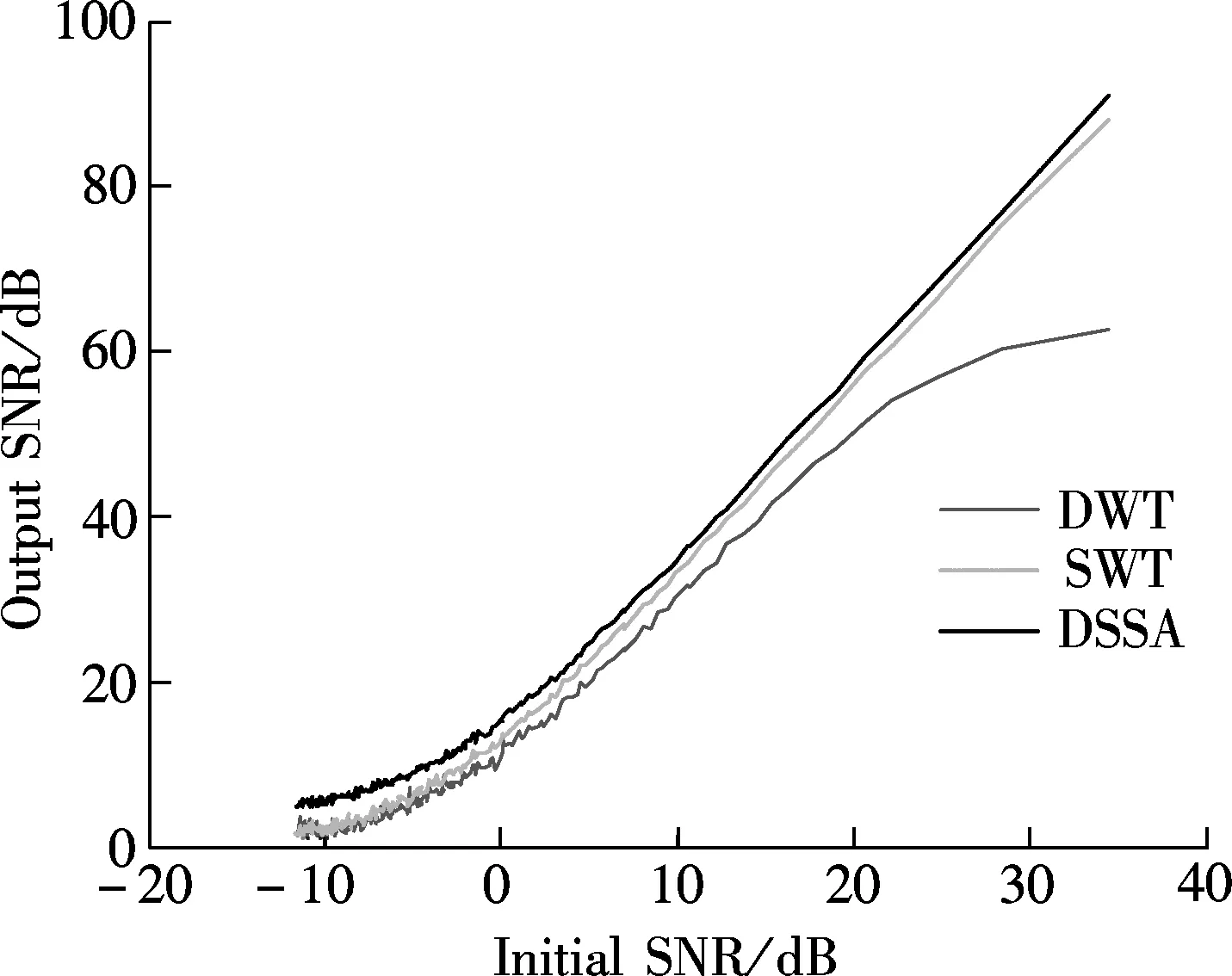A comparison analysis of multipath extract methods in short-baseline applications of GPS
2014-09-06CuiBingboChenXiyuan
Cui Bingbo Chen Xiyuan
(School of Instrument Science and Engineering, Southeast University, Nanjing 210096, China)
A comparison analysis of multipath extract methods in short-baseline applications of GPS
Cui Bingbo Chen Xiyuan
(School of Instrument Science and Engineering, Southeast University, Nanjing 210096, China)
In order to eliminate the multipath errors existing in static short-baseline applications, a novel de-noising method based on a singular spectrum analysis (named as DSSA) is introduced to extract multipath signals. The multipath error is extracted from the double difference (DD) residuals by DSSA and then applied to the correct multipath error in subsequent measurements based on the correlation among adjacent epochs. Methods based on discrete wavelet transform (DWT) and stationary wavelet transform (SWT) are introduced as comparisons of DSSA based on analysis of a simulated signal. Real baseline residuals are tested to verify different extract methods. Results show that compared with the SWT, the DSSA improves the root mean square (RMS) of the residual by 48.6% and achieves a time reduction of 75.3%.
multipath extraction; singular spectrum analysis; stationary wavelet transform
There are many systematic errors that can seriously reduce GPS positioning precision, but most of these errors can be largely eliminated by the double difference (DD) technique except for multipath error and receiver noise error. In short-baseline applications, there is a base station whose position is often fixed with a high accuracy previously and assumed to be free of multipaths. It is also assumed that only low-frequency multipath errors and thermal noises exist in DD residuals because the correlated errors of the two receivers can be canceled, then a denoising method can be used to extract a multipath from DD residuals. Methods based on wavelet analysis (WA) have been developed to mitigate multipaths in short-baseline applications[1-3]. It is a crucial and complicated task to select a suitable decomposing level and right wavelet basis for the wavelet de-noising method. Furthermore, WA-based methods have a non-adaptive nature; that is, once the basic wavelet is selected, one will have to use it to analyze all the data[4]. This non-adaptive characteristic can be reduced by employing sparse data introduced by information redundancies, which will be verified by simulated signals in this paper later. Singular spectrum analysis (SSA) is an effective and powerful tool for time series analysis in climatology, economics, biology, physics and medicine and other sciences[5]. SSA is derived from the decomposition of a time series in the study of dynamical systems, so it is suitable for real-time processing. We apply a de-noising method based on SSA (named as DSSA) to extract multipath errors according to its singular value distribution.
1 Multipath Mitigation Method
It is difficult to estimate the multipath in real-time as it varies with time and environment around the antenna, so, to the best of our knowledge, there is no effective method to mitigate multipaths in kinematic positioning surveys. However, in GPS static applications, the environment around the antenna changes little, which causes the multipath to be only influenced by the movement of satellites. Many multipath mitigation methods applied to short-baseline applications are based on the sidereal day-to-day repeating property of multipath signals[3,6],which always need a longer time observation and greater storage demands. We introduce a post process multipath mitigation method based on the correlation of multipaths among adjacent epochs. First, a data window of the DD residuals is chosen as the input of de-noising method. Secondly, the extracted multipath is used to correct DD residuals observed at a central epoch of the selected data set. The equivalent is as follows:
(1)

2 Multipath Extract
In some applications, such as signal de-noising and feature extraction, the desired performance is achieved by increasing the computational time and memory size. It is useful to produce a redundant transformation by ignoring the decimation stage in the filter bank of discrete wavelet transform (DWT). The stationary wavelet transform (SWT) is the one whose filters are upsampled at each decomposition level, which avoids data size reduction and provides information redundancies[2]. The de-noising methods based on DWT and SWT are used as comparisons herein.
2.1 Singular spectrum analysis
Much work has been done on the theory of the SSA[9-10]. After finishing the embedding of the time series, energy of the time series is organized into a trajectory matrix. A singular value decomposition (SVD) can be used to calculate the singular spectrum of the matrix. The SVD can also be used to calculate the low rank approximation of the trajectory matrix, based on which a signal free of noise can be obtained. The main concern of SSA de-noising is the selection of the rebuild rank. LetXbe anm×nmatrix, subject tom≥n, with rankr≤n. Letkbe a real number andk (2) The calculation of rebuild bank by finding the minimum value ofJ(k) is time consuming, which makes it impractical in real-time applications. In this paper, we only focus on the extraction of a slowly changed multipath; therefore, the selection of lag window size and rebuild rank can be selected using hand tuning. More details about signal rebuild of the SSA-based de-noising method can be found in Ref.[10]. 2.2 Performance evaluation In order to evaluate the methods described above, a simulated signals(t) is created as (3) wherew(t) is the Gaussian white noise. The simulated signal contains three sinusoidal waves representing typical GPS multipath wavelengths. Let SNR=20log(S/N) indicate the signal to noise ratio of the simulated signal.SandNare the root mean square (RMS) of signal and noise, respectively. Fig.1 is the de-noising result where the standard deviation ofw(t) is set to be 0.02τwith 1≤τ≤200. We can see from Fig.1 that DWT performs worse when the initial SNR increases. This demonstrates that the convention wavelet-based filter is non-adaptive and cannot be used when noise is fast time-varying. SWT performs better than DWT as it introduces information redundancies. When the initial SNR is lower than 0dB, DSSA performs better, which is due to the fact that the singular spectrum of noise and signal does not overlap. Fig.1 Results of different de-noising methods The baseline error calculated in an attitude determination system is studied to obtain further insight into the multipath mitigation. The data set adopted was downloaded from Internet and was used in Ref.[2] to verify a multipath extraction method based on SWT. Data was collected on October 29, 2006 at a sampling interval of 1 s. There were nine satellites (PRNS 1, 6, 10, 16, 17, 21, 22, 26, and 30) visible during the 600 s of data acquisition. In order to compare with SWT used in Ref.[2], the wavelet base selected is sym4 and the decomposition level is 3. We select lag window size asN/16, whereNis the length of data series to be analyzed by the DSSA. The rebuilt number of singular value is chosen asL/4, whereLis the lag window size. Fig.2 is the power spectral density of the denoised signal. We can see that DSSA performs better when the frequency is greater than 0.25 Hz and it retains the weak features of the signal in low frequency. Settingn=3 in Eq.(1), we can obtain the result of multipath mitigation based on the correlation of adjacent epochs when the multipath signal varies slowly(see Fig.3). DSSA performs better than SWT due to the fact that SWT deforms the information contained in the low frequency part of a noisy signal, which further deteriorates the correlation between adjacent epochs. Specific improvement is described in Tab.1. The improvements of root mean square (RMS) of the corrected baseline error using multipath extract are 84.8% and 92.2% by SWT and DSSA, respectively, and the corresponding de-noising time costs are 31.6ms and 7.8ms, which is calculated in the Matlab simulation environment installed on the PC with a CPU speed of 2.2 GHz. Fig.2 Power spectral density of de-noising result Fig.3 Result of multipath mitigation IndicatorRMS/mTime/msRawdata0.1384SWT0.021031.6DSSA0.01087.8 A new algorithm named DSSA was developed in this paper to extract multipaths in GPS static short-baseline applications. As only the multipath signal and thermal noise are contained in DD residuals, the extraction of multipaths can be realized by de-noising. Several de-noising methods are compared based on simulation data and the results show that DSSA and SWT perform better than DWT. Real GPS data set is adopted to verify the performance of DSSA in extracting multipath from the baseline error. Results show that compared with SWT, the time cost of DSSA is reduced by about 75.3%, which makes DSSA more suitable in multipath mitigation based on the correlation of multipaths among adjacent epochs. [1]Mosavi M R, Azarbad M R. Multipath error mitigation based on wavelet transform in L1 GPS receivers for kinematic applications [J].InternationalJournalofElectronicsandCommunications, 2013, 67(10):875-884. [2]Azarbad M R, Mosavi M R. A new method to mitigate multipath error in single-frequency GPS receiver with wavelet transform [J].GPSSolutions, 2014, 18(2):189-198. [3]Zhong P, Ding X L, Zheng D W. Adaptive wavelet transform based on cross-validation method and its application to GPS multipath mitigation [J].GPSSolutions, 2008, 12(2):109-117. [4]Su L, Zhao G L, Zhang R Y. Translation-invariant wavelet de-noising method with improved thresholding[C]//InternationalSymposiumonCommunicationsandInformationTechnologies. Beijing, China, 2005: 599-602. [5]Hassani H, Soofi A S, Zhigljavsky A A. Predicting daily exchange rate with singular spectrum analysis[J].NonlinearAnalysis:RealWorldApplications, 2010, 11(3): 2023-2034. [6]Chen J, Shang X D, Zhao X. GPS multipath effect mitigation algorithm based on empirical mode decomposition [C]//Proceedingsofthe12thInternationalConferenceonEngineering,Science,Construction,andOperationsinChallengingEnvironments—EarthandSpace. Honolulu, USA, 2010:2395-2404. [7]Lau L. Comparison of measurement and position domain multipath filtering techniques with the repeatable GPS orbits for static antennas [J].SurveyReview, 2012, 44(324):9-16. [8]Dai W J, Huang D W, Cai C S. Multipath mitigation via component analysis methods for GPS dynamic deformation monitoring[J].GPSSolutions, 2014, 18(3):417-428. [9]Oropeza V E . The singular spectrum analysis method and its application to seismic data de-noising and reconstruction [D]. Edmonton, Alberta, Canada: Department of Physics, University of Alberta, 2010. [10]Chen Q, van Dam T, Sneeuw N, et al. Singular spectrum analysis for modeling seasonal signals for GPS time series [J].JournalofGeodynamics, 2013, 72:25-35. 短基线GPS应用中多径信号提取方法的对比分析 崔冰波 陈熙源 (东南大学仪器科学与工程学院, 南京 210096) 为了消除静态GPS短基线应用中的多径误差,引入了一种基于奇异谱分析的去噪方法(称为DSSA) 提取多径信号.首先,从双差分残差中提取出多径误差,然后,利用相邻历元间多径误差的相关性对双差分观测数据进行多径误差校正.为了验证DSSA算法的有效性,基于仿真信号对DSSA、离散小波变换(DWT)和平稳小波变换(SWT)的去噪方法进行对比分析.采用真实的GPS基线误差对不同的多径提取方法进行了分析,多径抑制结果表明,DSSA校正后基线误差的均方根(RMS)较SWT改善48.6%,运算时间减少了75.3%. 多径提取;奇异谱分析;平稳小波变换 TN967.1 s:The National Natural Science Foundation of China(No.51375087, 50975049),the Ocean Special Funds for Scientific Research on Public Causes(No.201205035-09). :Cui Bingbo, Chen Xiyuan.A comparison analysis of multipath extract methods in short-baseline applications of GPS[J].Journal of Southeast University (English Edition),2014,30(3):315-317. 10.3969/j.issn.1003-7985.2014.03.011 10.3969/j.issn.1003-7985.2014.03.011 Received 2014-02-28. Biographies:Cui Bingbo (1986—), male, graduate; Chen Xiyuan(corresponding author),male,doctor,professor, chxiyuan@seu.edu.cn.
3 Simulations and Analysis



4 Conclusion
猜你喜欢
杂志排行
Journal of Southeast University(English Edition)的其它文章
- P-FFT and FG-FFT with real coefficients algorithm for the EFIE
- Compressed sensing estimation of sparse underwateracoustic channels with a large time delay spread
- Improved metrics for evaluating fault detection efficiency of test suite
- Early-stage Internet traffic identification based on packet payload size
- An adaptive generation method for free curve trajectory based on NURBS
- Stability analysis of time-varying systems via parameter-dependent homogeneous Lyapunov functions
